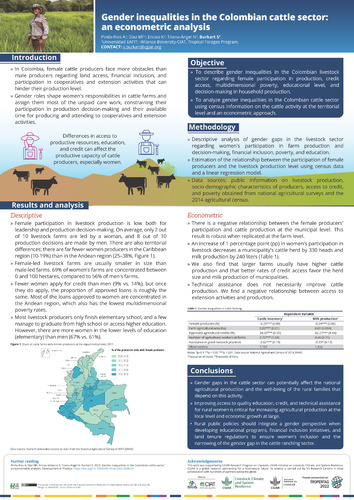Gender inequalities in the Colombian cattle sector: An econometric analysis
Abstract
Cattle is the most important agricultural activity in Colombia, representing around 30.6% of the national agricultural GDP and 19% of the agricultural (6% of the national) employment, surpassing the values of coffee and palm oil production by three and eight times, respectively. Despite its economic and social importance, the Colombian cattle sector is characterised by gender differences and inequalities, which are not yet fully understood. Although there exists research with both qualitative and mixed approaches, to date, there is no quantitative evidence that allows measuring the effect of gender gaps on cattle production. This research seeks to explore how gender inequalities in Colombia’s cattle sector affect household production, applying a quantitative and spatial approach based on a database that combines information on cattle production, household characteristics, and multidimensional deprivation at the departmental level. Our analysis shows that only one out of four cattle producers are women, but nearly half of them are heads of households responsible for the well-being of their families. Women also participate less than men in production decision-making, tend to have lower educational levels, request fewer agricultural credits, and have smaller farms. Municipalities where there are more female producers have lower milk production and cattle inventories, which coincides with the empirical evidence for other developing countries and may originate in the difficulty of women in accessing education, financing, and land, but also in time restrictions caused by domestic work, limiting their participation in extension activities and cooperatives. Likewise, the existing gender roles burden women with unpaid care and cleaning activities, instead of the administration and commercialisation of cattle, directly affecting their ability to own cattle. Our results bring to consideration how gender gaps in agriculture, and particularly in the cattle sector, have the potential to affect national agricultural production, and with it the well-being of rural families that depend on it, highlighting the importance of policy decisions that feature a gender approach. Through an active intervention of the State, particularly through education programs, credits for rural women, awareness creation of gender roles, and land tenure/inheritance regulations, a first step can be taken towards reducing gender gaps.

